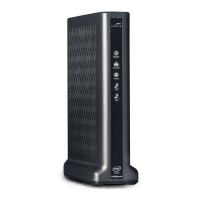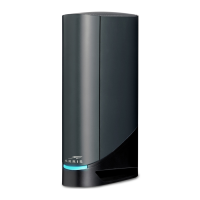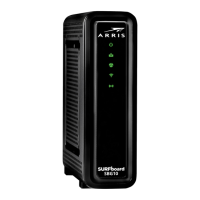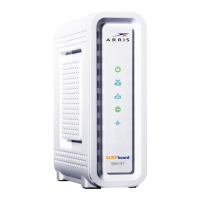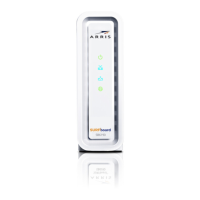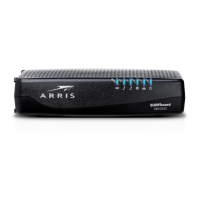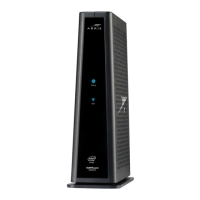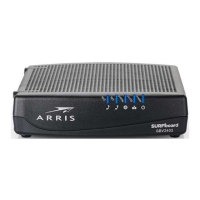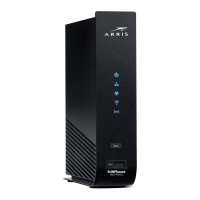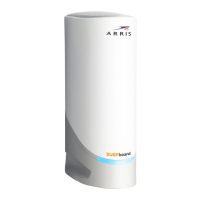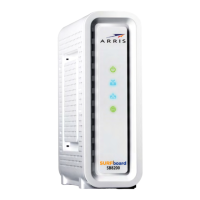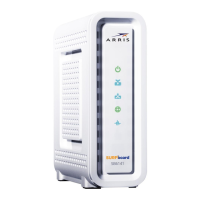Do you have a question about the Arris SURFboard TM822R and is the answer not in the manual?
Introduces the SURFboard TM822R Telephony Modem and its features.
Provides ARRIS support website for technical information and user guides.
Warns about potential damage and service loss from improper telephone wiring connections.
Alerts users to mains voltages inside and advises referring service to qualified personnel.
Warns about risks associated with incorrect battery types, heating, and disposal.
Details compliance with FCC rules for Class B digital devices and potential interference.
States compliance with FCC radiation exposure limits and minimum operating distance.
Outlines regulations for radio transmitters under Industry Canada license-exempt standards.
Specifies conditions for equipment operation in Mexico regarding interference.
Describes the features and capabilities of the SURFboard TM822R Telephony Modem.
Lists all the items included in the Telephony Modem package.
Lists additional items required if you are installing the modem yourself.
Describes coaxial and phone cables and their connection requirements.
Explains the use of a splitter for additional cable connections and potential signal impact.
Guides on contacting the service provider to establish Internet and telephone service.
Outlines the necessary system and service requirements for modem operation.
Specifies compatible Windows operating systems and Ethernet LAN connection.
Specifies compatible Mac OS versions and Ethernet LAN connection.
Lists requirements for Linux/Unix systems including drivers and TCP/IP.
Provides tips to enhance system security for high-speed Internet connections.
Explains using an Ethernet hub for connecting multiple computers to the modem.
Explains the battery backup feature for continued telephone service during power outages.
Describes basic backup battery models (green and black) and their backup times.
Describes extended backup battery types and their approximate backup times.
Provides step-by-step instructions for installing and replacing the basic backup battery.
Provides step-by-step instructions for installing and replacing the extended backup battery.
Provides step-by-step instructions for installing and replacing the maximum backup battery.
Details battery lifespan, calibration procedures, and proper storage.
Provides information on recycling rechargeable batteries through Call2Recycle.
Explains how to check the battery status via the modem's web interface.
Ensures service provider verification and availability of necessary items and outlets.
Describes the function of Link, Tel 1, Tel 2, Battery, Online, US, DS, and Power indicators.
Describes Tel 1/2, Tel 2, Ethernet, Coax, Power ports, and the Reset button.
Factors to consider when choosing a location for the modem.
Options for mounting the modem on a wall or desktop.
Lists tools and materials required for wall-mounting the modem.
Guidance on positioning the modem for AC and cable outlets.
Step-by-step instructions for securely mounting the modem on a wall.
Instructions for placing the modem on a desktop, ensuring proper ventilation.
Guides on connecting coax, power, Ethernet, and telephone cables.
Instructions for connecting the telephone cable to the modem and phone.
Lists prerequisites for configuring the computer's Ethernet connection.
Provides an overview of the procedures for setting up TCP/IP settings.
Step-by-step guide for configuring TCP/IP settings on Windows Vista.
Guide for configuring TCP/IP settings on Windows 7, 8, or 10 operating systems.
Guide for configuring TCP/IP settings on Mac OS X operating systems.
Guides on setting up the computer to work with the Telephony Modem.
Explains the meaning and function of the TM822R's LED indicator lights.
Addresses issues and solutions for an incompatible installed battery.
Guides on identifying and resolving issues related to telephone wiring.
Illustrates modem light patterns observed during normal operation.
Explains the modem's LED light patterns during the startup sequence.
Details the light patterns for the cable modem startup phase.
Explains how to use the recessed reset button for modem initialization.
Describes the procedure to start the modem using its battery backup.
Steps to troubleshoot when the modem's power light is off.
Guides for resolving issues with establishing an Internet connection.
Troubleshooting steps for Internet connectivity problems over Ethernet.
Addresses and provides solutions for slow internet connection speeds.
Guides on identifying and resolving issues related to the absence of dial tone.
Data Over Cable System Interface Specification: interoperability standards.
Standard method for connecting computers in a Local Area Network (LAN).
Cable used to connect to the cable TV system for modem and television.
Protocols used to facilitate communications across interconnected networks.
Number assigned to a computer for identification on the Internet.
Unique identifier for network-connected devices, used for authorization.
Embedded Multimedia Terminal Adapter: an MTA integrated with a cable modem.
Dynamic Host Configuration Protocol for assigning IP addresses and network services.
Introduces the SURFboard TM822R Telephony Modem and its features.
Provides ARRIS support website for technical information and user guides.
Warns about potential damage and service loss from improper telephone wiring connections.
Alerts users to mains voltages inside and advises referring service to qualified personnel.
Warns about risks associated with incorrect battery types, heating, and disposal.
Details compliance with FCC rules for Class B digital devices and potential interference.
States compliance with FCC radiation exposure limits and minimum operating distance.
Outlines regulations for radio transmitters under Industry Canada license-exempt standards.
Specifies conditions for equipment operation in Mexico regarding interference.
Describes the features and capabilities of the SURFboard TM822R Telephony Modem.
Lists all the items included in the Telephony Modem package.
Lists additional items required if you are installing the modem yourself.
Describes coaxial and phone cables and their connection requirements.
Explains the use of a splitter for additional cable connections and potential signal impact.
Guides on contacting the service provider to establish Internet and telephone service.
Outlines the necessary system and service requirements for modem operation.
Specifies compatible Windows operating systems and Ethernet LAN connection.
Specifies compatible Mac OS versions and Ethernet LAN connection.
Lists requirements for Linux/Unix systems including drivers and TCP/IP.
Provides tips to enhance system security for high-speed Internet connections.
Explains using an Ethernet hub for connecting multiple computers to the modem.
Explains the battery backup feature for continued telephone service during power outages.
Describes basic backup battery models (green and black) and their backup times.
Describes extended backup battery types and their approximate backup times.
Provides step-by-step instructions for installing and replacing the basic backup battery.
Provides step-by-step instructions for installing and replacing the extended backup battery.
Provides step-by-step instructions for installing and replacing the maximum backup battery.
Details battery lifespan, calibration procedures, and proper storage.
Provides information on recycling rechargeable batteries through Call2Recycle.
Explains how to check the battery status via the modem's web interface.
Ensures service provider verification and availability of necessary items and outlets.
Describes the function of Link, Tel 1, Tel 2, Battery, Online, US, DS, and Power indicators.
Describes Tel 1/2, Tel 2, Ethernet, Coax, Power ports, and the Reset button.
Factors to consider when choosing a location for the modem.
Options for mounting the modem on a wall or desktop.
Lists tools and materials required for wall-mounting the modem.
Guidance on positioning the modem for AC and cable outlets.
Step-by-step instructions for securely mounting the modem on a wall.
Instructions for placing the modem on a desktop, ensuring proper ventilation.
Guides on connecting coax, power, Ethernet, and telephone cables.
Instructions for connecting the telephone cable to the modem and phone.
Lists prerequisites for configuring the computer's Ethernet connection.
Provides an overview of the procedures for setting up TCP/IP settings.
Step-by-step guide for configuring TCP/IP settings on Windows Vista.
Guide for configuring TCP/IP settings on Windows 7, 8, or 10 operating systems.
Guide for configuring TCP/IP settings on Mac OS X operating systems.
Guides on setting up the computer to work with the Telephony Modem.
Explains the meaning and function of the TM822R's LED indicator lights.
Addresses issues and solutions for an incompatible installed battery.
Guides on identifying and resolving issues related to telephone wiring.
Illustrates modem light patterns observed during normal operation.
Explains the modem's LED light patterns during the startup sequence.
Details the light patterns for the cable modem startup phase.
Explains how to use the recessed reset button for modem initialization.
Describes the procedure to start the modem using its battery backup.
Steps to troubleshoot when the modem's power light is off.
Guides for resolving issues with establishing an Internet connection.
Troubleshooting steps for Internet connectivity problems over Ethernet.
Addresses and provides solutions for slow internet connection speeds.
Guides on identifying and resolving issues related to the absence of dial tone.
Data Over Cable System Interface Specification: interoperability standards.
Standard method for connecting computers in a Local Area Network (LAN).
Cable used to connect to the cable TV system for modem and television.
Protocols used to facilitate communications across interconnected networks.
Number assigned to a computer for identification on the Internet.
Unique identifier for network-connected devices, used for authorization.
Embedded Multimedia Terminal Adapter: an MTA integrated with a cable modem.
Dynamic Host Configuration Protocol for assigning IP addresses and network services.
